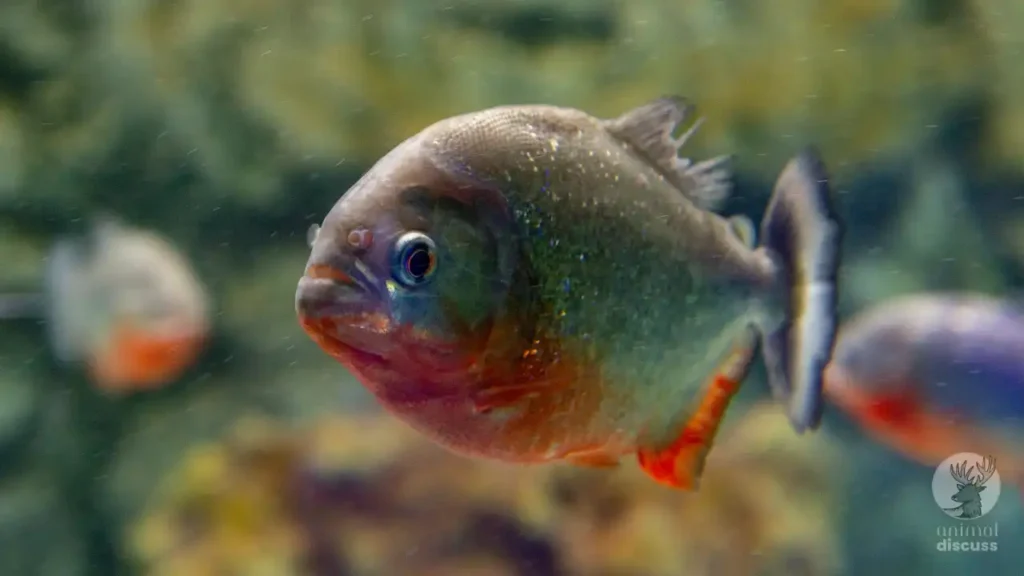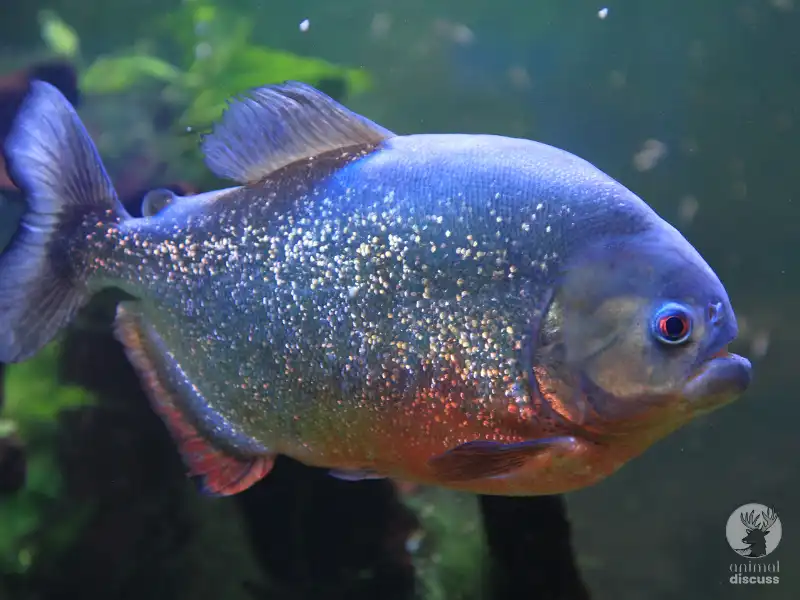Wondering about where piranhas thrive in the wild? Then you have to know about the places and preferences of their dwelling.
Basically, piranhas live in the rivers and lakes of South America, especially in the Amazon basin. Again, they prefer warm, muddy waters with lots of plants.
Moreover, they hunt in groups, which can be interesting but also dangerous for other animals.
Now, let’s not swim away, instead, we should dive into the diverse habitat of piranhas to know all the secrets!
Piranhas’ Habitat Distribution
Do you know, South America has been home to piranhas for millions of years? These days, piranhas live in South America’s freshwaters. They range from Venezuela’s Orinoco River Basin to Argentina’s Paraná River.

Approximately thirty species of piranha currently live in South America’s rivers and lakes, while the exact numbers are unknown. Extant piranha taxa which include various species belonging to the genera- Pygocentrus, Serrasalmus, and Rooseveltiella. They may have only existed for 1.8 million years.
You will be surprised to know that Piranhas discovered outside of South America are typically escaped or released pets.
In this fashion, piranhas have appeared in waterways all across the world, from Texas to China to Great Britain. Also, in certain places, it is permissible to keep piranhas. But it is never an excellent choice to let them go into the wild since they could become aggressive.
If you are willing to have more knowledge about piranha overview then you should read this article.
In Which Places Piranhas are Mostly Found?
For your convenience, I have added a table regarding an overview of the distribution or habitat of piranhas across South America. I have also focused on key locations such as the Amazon, Orinoco, Sao Francisco, and Parana rivers as well as Venezuela, Brazil, and Argentina.
The tables will show you the diverse habitats where piranhas can be predominantly found, and it discusses notable species. So, let’s check out!
| Location | Description |
|---|---|
| Amazon Basin | 01. Its interconnected rivers, tributaries, and flooded forests provide ideal habitats for piranhas 02. Has a vast and diverse ecosystem that is preferred for piranhas 03. Here, piranhas play a crucial role in its ecosystem as both prey and predators 04. They can contribute to the balance of aquatic life in this water |
| Amazon River | 01. Along with its associated rivers, it serves as the primary habitat of piranhas 02. Hosts approximately 20 different species 03. Most of the piranhas in this water are peaceful except the red-bellied and black piranhas 04. Piranhas in this river are opportunistic feeders that consume a variety of food including fish, insects, and plant materials |
| Orinoco River | 01. Contains approximately 60 species of piranhas including the Black piranha (Pygocentrus cariba) 02. Piranhas in this river are sought after as game fish and can grow up to 11 inches in length |
| Sao Francisco River | 01. Home to the piranha species Pygocentrus piraya which is known for its aggression and large size 02. Piranhas get insects, small fish, seeds, and plants in this water, and can be fierce predators when hunting live prey |
| Parana River | 01. One of the longest rivers globally that produces a habitat for various piranha species including the Speckled piranha 02. Supports diverse aquatic life and is vital for fishing industries in the surrounding areas |
| Venezuela | 01. In the Llanos region and Colombia, there are 13 different species of piranhas 02. Contains genera such as Pygocentrus, Serrasalmus, and Pristobrycon |
| Brazil | 01. The largest wetland named the Pantanal is home to the Red-bellied piranha which has increased in frequency in certain regions 02. Dammed streams and rivers in the state of Sao Paulo have reported incidents of piranha attacks on swimmers 03. Red-bellied piranhas are common to Northern Brazilian coastal rivers |
| Argentina | 01. Found three species of piranhas- Pygocentrus nattereri, Serrasalmus marginatus, and Serrasalmus maculatus, primarily in the lower Parana River 02. Serrasalmus maculatus inhabits ponds and usually lives in small groups 03. Serrasalmus marginatus is found in the Rio Parana and Rio Paraguay drainage system, spanning Brazil, Paraguay, Argentina, and Uruguay 04. Pygocentrus nattereri or the red-bellied piranha is native to Amazon, Paraguay, Parana basins, and Essequibo |
Well, do you know what the main food sources of piranhas are in those places? Piranhas primarily feed on fish in those places but also consume other aquatic organisms like crabs, worms, and insects.

Now you may have one more question- is there any place left that can be enlisted as a piranha habitat other than these? Then, the answer will be “Yes”. The piranhas have been discovered in rivers in distant locations like China and Britain.
However, the majority of piranhas that are present across the world were initially added to backyard ponds or public aquariums. Because fish are so beautiful and unusual, some people adore having them as pets.
So, I think you got it and understood from the table and the discussion that there are so many places for piranhas where they can thrive frequently!
Can Piranha Make a Good Pet?
Yes. One of the finest pets you can have is a piranha! The best thing is that owning a fish tank filled with gnarly pet piranhas doesn’t need you to be a villain.
Piranhas are raised frequently by pet fish “connoisseurs” around the globe, who enthusiastically report on how intriguing they are to own as pets.

Though in the wild there are many varieties of piranhas, only a select handful are kept as pets. Because they are tamed down and easier to handle in captivity.
Piranhas come in more than 20 species, each with unique traits and ways of behaving. The Red Bellied Piranha is the most popular and ideal species of piranha to maintain as a pet.
It is considered the least violent member of the piranha family. Besides, this species is regarded as “affordable” due to its ease of maintenance.
What Types of Water Piranhas Need to Thrive?
Did you ever think about what kind of water piranhas need to thrive?
Well, here is a scoop: nearly all red-bellied piranhas you see for sale these days are bred intensely in water. This tells us a lot about the specific aquatic conditions these fish prefer to flourish.
However, the water used for piranha farming frequently has higher levels of pH and alkalinity compared to their native environments. Also, there is the fact that piranhas thrive naturally in softer and lower pH water.

So, this indicates that the water parameters in these farming setups can be different from the conditions piranhas are accustomed to in the wild. They can adapt to tap water if extraordinary measures are taken.
So, alkalinity should range from 50 ppm to 140 ppm. Also, pH needs to be from 6.5 to 7.8, and temperature should be between 75° and 80° F. Set up an Aquarium Heater just to keep the aquarium at the right temperature if it is housed in a space that isn’t 75°.
Similar to numerous tetras along with silver-scaled fish, piranhas can become ill if the temperature drops too much. They are also sensitive to abrupt temperature fluctuations.
Accommodation Needs for Piranhas in Captivity and Care Tips
Finding room in your house is the biggest issue when deciding where to keep a pet piranha. Because they need such enormous tanks.
- In captivity, adult piranhas eventually require a clean aquarium.
- It can be at least 100 gallons, or more, according to how many of them you have.
- Baby piranhas are able to be kept periodically in aquariums as little as 20 gallons.
- They need a tastefully furnished aquarium featuring a dark background and muted lighting. Because of these, they will be more relaxed and display their most vibrant colors.
- Keep the tank cover securely in place to keep them from leaping out if they sense danger or fear. You must give a gentle, consistent current.
- Since adults as pets tend to be messy eaters, it is advised to use numerous filters or a slightly bigger filter that has good biological and mechanical capabilities.
- Before purchasing piranhas as pets, careful thought should be given to tank size because they grow large. Such a mature Red Bellied Piranha requires no less than 25 gallons of water. And Black and Ruby Red piranhas require more than 40 gallons of water.
- The tank needs to be well-stocked with plants, hiding spots, and enough acclimation.
- It is important to regularly check the pH, temperature, and other environmental factors of the tank water.
- Since they dislike warm water, you should keep them out of the sun and severe heat.
- Also, Keep an eye out for violent behavior.
- Occasionally provide them with live food.
Further, you have to remember that piranhas consume a lot, create filth, and have a long lifespan. It is a last resort in an emergency. So, taking them back to the fish shop or finding new homes should never be decided upon hastily.
Habitat Threats and Conservation Status
Although they may have a strong exterior, piranhas’ habitat is seriously threatened! Their homes may become contaminated by pollution done by human activities such as mining and deforestation. These are making it difficult for them to get clean water and wholesome food.

Moreover, overfishing and river pollution disrupt the piranhas’ feeding chains. So, it keeps them hungry and lets them fight for survival. In order for these ferocious fish to continue flourishing in the wild, we must defend their habitat.
The IUCN normally classifies piranhas as “not evaluated” or “least concern.” This implies that neither the population of the fish nor its extinction is in trouble. Nevertheless, the piranha is affected by habitat destruction, food source loss, and climate change, just like all other marine animals worldwide.
Frequently Asked Questions
Have more curiosity regarding their residence? Then check out the FAQs.
01. Do piranhas exist in Asia?
Yes. Additionally, piranhas have been found in southeast Bangladesh’s Kaptai Lake. It’s a wonder to determine how piranhas left their native home and traveled to such far-flung parts of the globe.
02. Is there piranha fish in India?
Yes. The Godavari have been reported to have red-bellied piranhas. Piranhas were initially discovered in 2014, thanks to the Wildlife Institute of India (WII), Dehradun. They were found close to the Dowleswaram barrage in Rajahmundry. Since then, the fish has been spotted multiple times.
03. Are piranhas able to survive in saltwater?
Yes. Freshwater streams and lakes in South America are home to all species of piranhas. Certain fish species are found in freshwater, saltwater, and brackish water settings.
Final Thoughts
Finally, we can say that, in the heart of South American jungles, the habitat of piranhas’ pulses with both danger and intrigue! These formidable fish thrive in muddy waters. Their dense foliage casts ghostly shadows and conceals their razor-sharp teeth.
Yet, beneath the surface lies a delicate ecosystem worth protecting. Conservation efforts are vital to preserve their habitat and ensure the balance of nature endures. By safeguarding their home, we not only protect the piranhas but also the myriad of species that depend on this unique environment.
Together, let’s dive into action to safeguard their habitat and the rich biodiversity it sustains!
References
- https://www.smithsonianmag.com/science-nature/14-fun-facts-about-piranhas-180951948/
- https://checklist.pensoft.net/article/19152/
- https://wildlife.ca.gov/Conservation/Invasives/Species
- https://www.aqueon.com/resources/care-guides/piranha

